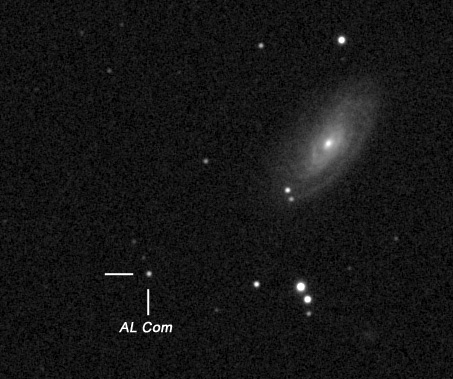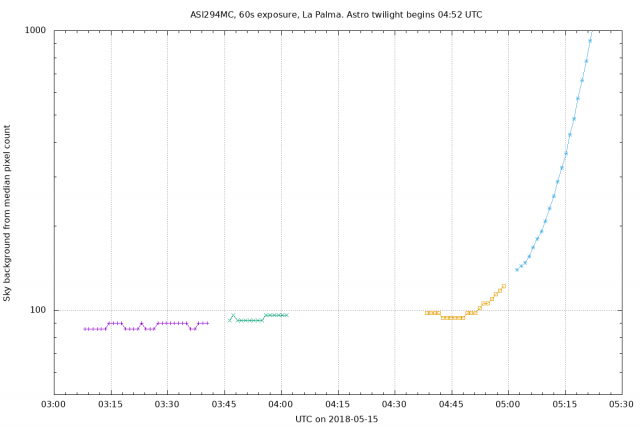Forum Replies Created
-
AuthorPosts
-
 Nick JamesParticipant
Nick JamesParticipantI’ve been to LP many times and I wouldn’t say that it was that easy to get to. Sites around southern Spain are much better served by frequent easyJet (other low cost airlines are available) flights. This is a consideration when you need to go out to repair something.
 Nick JamesParticipant
Nick JamesParticipantKevin’s talk on setting up his remote observatory at your place on LP is here. It’s worth watching to see how much commitment is required to keep things working. I think this is something that the BAA should certainly consider but I’d be interested on thoughts about whether to do it this way or use a fully supported PAYG system such as iTelescope.
 Nick JamesParticipant
Nick JamesParticipantThey are being processed on the website at the moment but it has taken all day to get to talk number 4 and there are 10 of them. It will probably be tomorrow before they are online. You’ll find them on the meetings page here when they are done. Coincidentally I am currently requesting that the BAA WebOps team remove the very slow video transcode that causes the delay.
 Nick JamesParticipant
Nick JamesParticipantI don’t think so. The flashes along the trail look like navigation lights to me. Sputnik 1 was a shiny sphere and so wouldn’t flash in that way. This is the picture I showed in the talk.
 Nick JamesParticipant
Nick JamesParticipantAll the videos are now available here. Apologies again for the poor sound quality.
 Nick JamesParticipant
Nick JamesParticipantYes, very variable brightness and separation. I’ve posted a frame from my video here. I’ll put the full video up shortly.
 Nick JamesParticipant
Nick JamesParticipantThanks Paul. I’ll have a look when I get a dull moment.
 Nick JamesParticipant
Nick JamesParticipantHad a video running for this evening’s 2130 UTC pass. The sky was bright and cloudy but I recorded 14 of the Starlink spacecraft. I was using a Sony A7s with an 85mm lens at f/1.4, 1/25s, ISO20000 pointed just left of Spica. The first one came along at the time predicted but the rest were strung out over around 3.5 mins. Limiting mag of the video was around 7.5. The spacecraft were all around mag 5.5.
 Nick JamesParticipant
Nick JamesParticipantI’m suprised by that. I use winsorized sigma clipping with dithering for all my stacks since I have planes, helicopters etc. to deal with in addition to satellites and dark frames are never perfect. I’ve never noticed any degradation in the photometric accuracy of my stacks using sigma clip compared to a simple mean. In fact I would have thought that it would be better since you are removing residual hot pixel outliers. As Grant says, it would be interesting to see a reference that discusses this.
 Nick JamesParticipant
Nick JamesParticipantNot good from our latitudes in the summer but another reason for imagers to use short subs and sigma clip stacking I guess. Not sure of the effect on surveys like LSST. It will be imaging only after the end of astro twilight and it is at latitude 30S so twilight will be much shorter. I guess someone could calculate the period of time during astro night when 500km high LEOs are illuminated from that site.
 Nick JamesParticipant
Nick JamesParticipantCalsky has an amateur generated TLE for the train and will do predictions. Use Spacecom ID 99201. The TLEs are currently over a day old and the orbits will be evolving quite rapidly as each spacecraft uses its ion thruster to move to its operational configuration. The prospect of 12,000 of these things in LEO is indeed a concern for astronomers although there will be long periods when they are not illuminated.
It was cloudy in Essex last night but John Mason had clear skies for the low pass at 22:16 UTC and didn’t see anything.
Epoch is 24. May 2019 Starlink Trail1 99201U 19894A 19144.95562291 .00000000 00000-0 50000-4 0 022 99201 53.0084 171.3414 0001000 0.0000 72.1720 15.40507866 06 Nick JamesParticipant
Nick JamesParticipantI’m pleased to say that video and audio from all of the talks on Saturday appear to have recorded correctly. I should be able to post the videos in the next week or so.
 Nick JamesParticipant
Nick JamesParticipantIf you are coming to the meeting on Saturday by car please see the directions attached. There is limited parking in the school carpark near the venue. Alternatively there is paid parking in Nunnery Lane. York has a number of Park and Rides which may also be an option.
Hoping to see you there.
 Nick JamesParticipant
Nick JamesParticipantI hope to have video. I’ll let you know after the event.
 Nick JamesParticipant
Nick JamesParticipantThat’s a really interesting report. Prentice and Alcock would be amazed at so many high quality meteoroid orbits in such a short time.
 Nick JamesParticipant
Nick JamesParticipantI get 14.11 G tonight using a 90mm refractor from Chelmsford and the green pixels from an RGB detector. There are lots of galaxies in the field although the conditions here are very hazy.

 Nick JamesParticipant
Nick JamesParticipantBizarre indeed. I wonder how many TLPs it inserts?
15 April 2019 at 8:20 am in reply to: Very bright fireball on Saturday morning, March 30, at 03:52 GMT #580975 Nick JamesParticipant
Nick JamesParticipantIt was a sporadic.
 Nick JamesParticipant2 April 2019 at 8:16 pm in reply to: Does it get darker after the end of Astronomical twilight? #580925
Nick JamesParticipant2 April 2019 at 8:16 pm in reply to: Does it get darker after the end of Astronomical twilight? #580925 Nick JamesParticipant
Nick JamesParticipantI very much doubt if you could detect any natural scattered sunlight in the sky after the end of astro twilight from anywhere in southern England. I’m not sure how stable the SQM photometer is but I imagine you are detecting man-made scattered light. You would need to have a very good sky for natural sources such as airglow to have a detectable effect.
I attach a plot from “Sunsets, twilights and evening skies” by Aden and Meinel. This is a lovely book and has several chapters on twilight. Also, a plot from an imaging session on La Palma where the skies are really dark and, in this case, very transparent . This shows the median sky background for several imaging sessions of objects at different altitudes. Astro twilight begins at 04:52 and it is only just detectable even from a place with very dark skies.
It’s all a bit academic for me in Chelmsford. On very good nights I can only just detect the sun in my skies when it is between 15-16 deg below the horizon!

-
AuthorPosts
